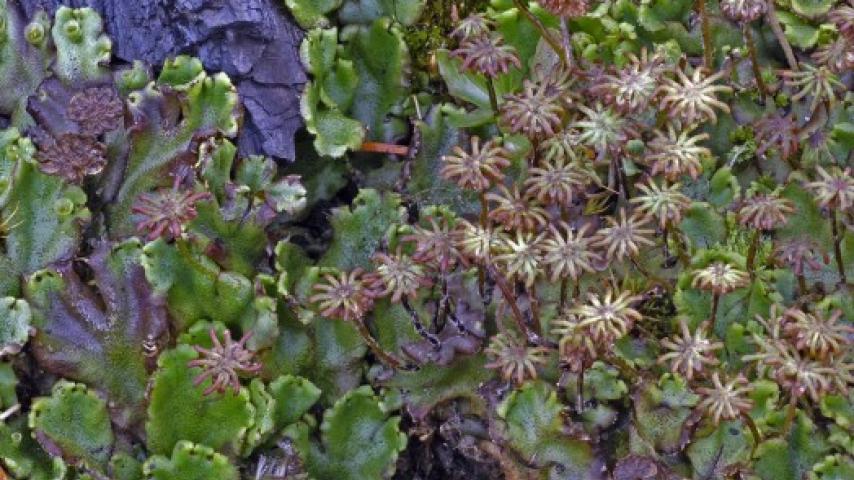Thallose Liverwort (Marchantia polymorpha)
Liverworts are primitive nonvascular plants, perhaps the most primitive true plants still in existence.

KINGDOM Plantae - PHYLUM Hepatophyta - CLASS Marchantiopsida - ORDER Marchantiales - FAMILY Marchantiaceae
There are two types. In thallose liverworts, the plant body (thallus) consists of flattened masses of cells that look leafy but show little differentiation into different cell types. A layer of photosynthetic tissue is underlain by nonphotosynthetic cells, with a final lower scaly layer that produces rhizoids, root-like structures that help hold the plant in place. Leafy liverworts look more like mosses, with obvious small leaves along a stem. But the leaves may bear marginal cilia (very rare in mosses) and never have a costa (present in most mosses).
Like other primitive plants, liverworts are not well adapted to dry situations, so they grow where the soil is moist and humidity high. Pores in the uppermost cell layer allow moisture into the cells, and they close as the thallus dries out, but there is no active closing and opening like the stomata of higher plants.
Both types of liverworts are small, in the range of a few millimeters to a few centimeters, and easily overlooked. Some species, however, are conspicuous members of the forest-floor flora and may be much easier to find. One of these is Marchantia polymorpha. a thallose species. This species has spread around the world and, where common, covers moist substrates along with mosses. It can even be a pest in greenhouses, where it can cover the surfaces of plant containers, trays, and even floors.
The conspicuous plants that we see are the gametophytes. Asexual reproduction occurs by budding, as older parts of the plant die and newer parts develop into separate plants. It also occurs by clusters of cells contained in gemmae cups, cuplike structures on the upper surface of the thallus. When raindrops hit the cups, they splash these clusters of cells out into the surroundings, and they grow into new gametophytes.
Sexual reproduction is easy to envision in Marchantia, which is dioecious (males and females on separate plants). Both sexes produce gametophores that project above the thallus. Those in the female plants look like little umbrellas. They produce eggs in archegonia that are fertilized by the sperm shed from the male antheridia. The male antheridia are distinguished by their starlike rays. The fertilized egg develops into a sporophyte, a tiny plant that remains attached to the gametophyte. The sporophyte produces spores that are dispersed by wind and water and develop into new male and female plants.